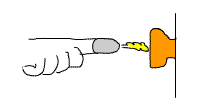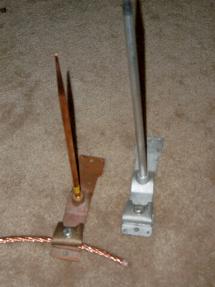
Controlling Static Electricity
A major nuisance of static electricity is that many people get unexpected shocks, simply from touching some metal object after walking across the room. There are also some situations where excess static electricity can damage equipment or even pose a danger. It is something you may want to stop or control. There are many ways to eliminate or decrease static electricity and the sparks or shocks caused by releasing it.
Static electricity is more active when the air and materials are dry. The humidity is normally lower in the winter, and heating the house further reduces the humidity. Also, in locations with a desert climate usually have very low relative humidity. One thing you can do is to use a humidifier to raise the humidity in the house. Higher humidity allows moisture to coat the surface of materials making it harder for protons and electrons to stick to it.
We know static electricity works better in drier areas and weather. Similarly, dry skin makes it easier for an imbalance in electrons to occur. Using lotion to moisturize your skin can help prevent the imbalance of electrons by coating your hands and keeping atomic particles from sticking to them.
Another idea is to use a metal object like a key and touch other metal things first with key. This will cause the spark to fly from the key and not your finger. That is much more comfortable. You can also use a ring or even a thimble to move the shock from your finger to the metal object.

Using a thimble to protect finger
from shock before touching doorknob
One more thing to do is to try to ground yourself before touching another person or something metal. You can touch a wall or wooden table or something. Another way is to use a ring or a key and touch something metal. Let the spark fly that way instead of off your finger.
As with the car keys, the problem can also be prevented by discharging your excess body-charge in some way that doesn't cause pain. Touching non-metal items can help to reduce or remove the imbalance of electrons to limit the static electricity. This can be done by:
When certain materials rub together, they build up static electricity. Items that commonly rub together to cause static electricity are:
Refering to the Triboelectric Series can also tell you which materials are most susceptible to static electricity.
Clothes
Some clothing materials cause more static electricity than others. This can be seen by objects that cling together when you take them out of the clothes dryer. Using dryer sheets, like Bounce, coat the clothes to prevent excess electrons from sticking to them.
When you slide out of a car or off furniture in the house, you can create static electricity if the combination of materials is right. Try putting a cover on the seat, change the materials or your clothes, or perhaps spray things with an antistatic spray, such as is used to prevent static cling.
Soles of shoes
People get shocks from walking on the rug in the house, jumping on a trampoline, or playing basketball in the gym. Certain synthetic rubber soles on shoes create a lot of static electricity. Experiment with different shoes.
The reason you build up static electricity usually comes from walking on a rug with certain types of shoes, when the weather is very dry. Static electricity is more common in the winter, because the air is often dry.
On a day that you get a lot of sparks, you can experiment walking on the rug with different shoes to see what type of soles create the most (or least) static electricity.
Unless you can change the type of shoes you wear (or not wear shoes at all), it is difficult to stop the problems of sparks. The only other solution is to anticipate the sparks. You can touch some non-conducting material, such as a wooden door, before you touch something metal. This will allow some of the electrical charges to leave your body.
When many gallons of gasoline are transferred from a truck into the underground tank at a filling station, there is a lot of friction caused by the gasoline flow. Also, since the fuel is very inflammable, a single spark caused by static electricity could cause an explosion. Thus, the truck uses a grounding device on the hose that draws the electrical charges away from the gasoline, preventing any static sparks from occurring.
People who are filling a gasoline container at the pump are advised to use caution to avoid static sparks. When you slide out of your car, touch something metal to get rid of any excess charges. It is also recommended to place the container on the ground when filling it.
The way to protect a building that is out in the open—such as those on farms—is to attach a lightning rod to the building. It is a sharp pointed metal rod on the top of a house or barn that runs down into the ground.
When lightning strikes near the building, it would hit the highest part of the structure, which is the lightning rod. Since the rod is made of metal, the current would quickly flow through the rod, into the ground, where it would be dissipated. In this way, damage to the house would be minimal. For a long time people thought that the static electricity was attracted to the pointed end of the rod. Recent studies showed that a larger, rounded surface would be effective than a sharp point.
